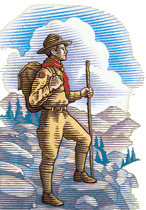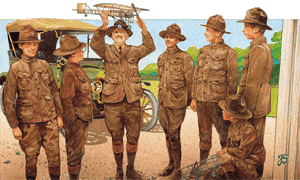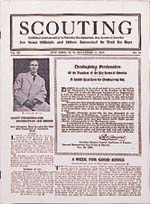Scouting--September 1998


The Training of Pioneer Scout Leaders
By Robert Peterson
No formal training courses or official handbooks were
available to the first adult leaders of Boy Scout troops, so many looked to
their own experiences for program ideas.
About two-thirds of the men who became Scoutmasters during the infancy of
the Boy Scouts of America already had some experience in working with boys.
They were Sunday school teachers, public school teachers, and leaders of
the Young Men's Christian Association, Boys Clubs, and various small
organizations for boys.

It was a good thing they had dealt with boys, because they did not get much
instruction in how to lead Boy Scouts.
The pioneers were pretty much on their own for training. A lucky few were
trained by the BSA's national leaders during the organization's first two
years--1910 and 1911. In those years about 40 Scout leaders were invited
to a two-week summer camp at the YMCA's camp at Silver Bay on Lake George
in upstate New York.
They received instructions in Scoutcraft and troop management from leaders
of the young BSA, including Chief Scout Ernest Thompson Seton, Daniel Carter
Beard, and Chief Scout Executive James E. West.
In 1912 similar Scoutmaster schools were held at Lake Geneva, Wis.; Blue Ridge,
N.C.; Cos Cob, Conn., as well as at Silver Bay.
Handbooks, magazines, personal interests
For thousands of men who organized or took over troops in the early years, such
training was only a dream. They had to rely on the Handbook for Boys (the
first edition of the BSA Scout handbook) for program ideas until 1913 when a
Handbook for Scoutmasters was published and Scouting magazine was
born.
The official handbook and magazine became sources of Scoutcraft ideas and
inspiration. So did Boys' Life magazine, which the BSA began publishing
a year earlier.
Many Scoutmasters looked to their own interests for program ideas. The first
troop in Logansport, Ind., for example, had "sergeants" and "corporals" instead
of patrol leaders and assistant PLs because the Scoutmaster was a
Spanish-American War veteran.
Albert Drompp, who joined the troop in 1912, remembered: "He wasn't too well
acquainted with Scouting. His activities for uswere marching and camping--things
he knew something about."
Scoutmasters who were amateur astronomers, ham radio operators, or had some other
hobby often featured it in troop meetings.
Scoutmasters looked to each other for help. By 1912 Scoutmasters in Philadelphia;
Paterson and Jersey City, N.J.; Tulsa; Cleveland; and Kansas City, Mo., had formed
associations that held regular "round tables" to thrash out problems.
Scoutmasters also exchanged ideas in a Scouting magazine page called "From
the Scout Field."
Learning in the classroom
From Scouting's beginnings, educators took an interest in the movement, seeing
it as a useful adjunct to the classroom. So it is not surprising that colleges
and universities began offering summer and evening courses for Scoutmasters.
In 1913, Cornell and Columbia universities and the universities of Virginia,
Wisconsin, Texas, and California began summer courses. By the mid-1930s, more than
400 colleges and 34 theological schools had courses for Scout leaders--half of
them for college credit. For three years during the 1920s, Columbia also had a
correspondence course for Scoutmasters.
In 1916 the National Council set up a Department of Education and gave it the task
of promoting training for both volunteer and professional Scouters. At first it
did not develop training courses. Rather, it published materials on how to train
Scouters in such skills as first aid, fire-building, outdoor cooking, knot-tying,
and signaling.
A variety of council courses
Local councils were responsible for creating their own Scoutmaster training courses.
In 1920 an article in Scouting summarized the courses being offered by 42 local
councils. The courses varied widely in length and content. Some lasted six sessions,
others 12.
Nearly all the courses included training in first aid, nature study, the Tenderfoot
requirements, hiking skills, and Scout games. There was less concentration on such
topics as troop meeting programs, discipline, troop records, and the duties of
troop committees.
The training of Scoutmasters was gradually formalized during the 1920s. A Volunteer
Training Service was added to the education de-partment, and by the mid-1930s a
Scoutmaster's Training Course was available to local councils.
Although training for Scouters evolved somewhat slowly in the movement's early years,
the BSA eventually developed one of the country's outstanding training programs for
volunteer leaders.
No one appreciated the importance of training more than Chief Scout Executive James
E. West, who once was asked to list the three most pressing needs of the BSA.
He wrote, "1--training; 2--more training; 3--even more training."
Contributing editor Robert Peterson wrote "The 85-Year Trail of Scouting Magazine" in
the March-April issue.
Scouting Magazine Was an Early Forum for Program Ideas
The BSA publication for leaders, Scouting first appeared in March 1913 as an eight-page
"bulletin," or newsletter. Even before it evolved into a full-fledged magazine in the 1920s,
the publication offered Scouters an assortment of program ideas. (The third issue contained
the article "Preparing for a Scout Camp.")
A popular section was "From the Scout Field," in which Scout leaders exchanged program ideas.
Some examples:

- One feature of our work is a "Good Turn Station," where a couple of Scouts are on
duty every evening to serve people who call for such help as they can give. We also have
a troop bank, in which nearly all the boys have an account. One dollar is the maximum
amount a boy is allowed to have to his credit. He is required to deposit in a public
bank if his account runs over this amount.
I. S. Abrahams, Scoutmaster
Albany, N.Y.
- Although we have 52 boys in the troop, we are not going to hold a summer camp
this year. Instead, we are taking weekly overnight hikes to the many different places
of interest around town. I can take along all the boys, whereas in the other plan some
boys cannot afford camp expenses and others cannot spare the time. Everyone can take a
day each week, and the expense is very light. We start every Wednesday at 7 a.m. and
hike home in the cool of the evening.
O. C. Riley
Auburn, N.Y.
- We appoint one or two members to visit other troops one night a month to get any
point that might be helpful to our troop.
Scoutmaster S. C. Ging
Indiana
- Our troop is located in the center of a farming community, and we take our hikes
every two weeks. When we start, I send one patrol through one field and another through
another. I made a scale of merit points as follows: for every thistle destroyed--10
points; mustard--7; burdock--5, and sourdock--3. When we reach our camping grounds, the
patrol having the most points was not obliged to help prepare dinner. In this way we
gained great favor with the farmers, and soon they all wanted us to hike through their
fields.
Scoutmaster H. W. Gehant
Illinois
|
Top of page
Return to Scouting table of contents
Copyright © 1998 by the Boy Scouts of America. All rights thereunder
reserved; anything appearing in Scouting magazine or on its Web site may
not be reprinted either wholly or in part without written permission.
Because of freedom given authors, opinions may not reflect official
concurrence.


